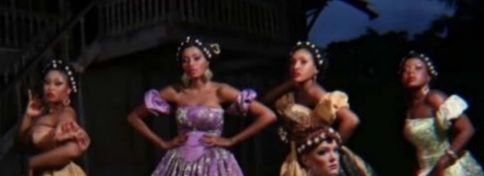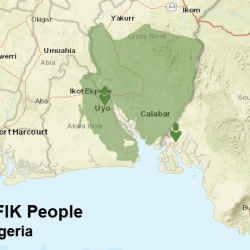Mbopo is the initiation of young girls into womanhood practiced among Ibibio people.

Mbopo ritual popularly referred to as the “fattening room” in anthropology was a
cultural rite of passage for young women who were being prepared for marriage among the
Ibibio people of southern Nigeria. It was a complex pre-marital cultural institution

The word “Mbopo” means “maiden” in another way “fattening”
In Ibibio society it was customary to perform certain cultural rites on young girls before they got married.
One of such rites was fattening, that is, she has to go through a period of seclusion before marriage.
This was done at puberty, which was usually marked or determined by the girl’s breast being noticeable.

The young girl is taught many things that would enable her to succeed in her home when she eventually settles in her husband’s house.
She is taught indigenous dances, folk songs, folk tales, and the culture of her people, as well as the history of her family, walking gracefully like a lady.

Old women who have passed through it will lecture her on how to live peacefully with her husband, her parents-in-law and relatives.
She is also given lessons on the nursing and caring for her children pending when she would have them.
The emergence of a “fat and beautiful” girl from a regulated period of seclusion in ekuk mbopo is important for the sustenance of a community.
Yet, of equal value to her appearance is that she be
imbued with strength as well as the skill required to handle the unrelenting rigors of womanhood.
Mbopo ritual is concerned with female corporeality, especially
with respect to physical modifications to beautify that empower the initiate.
In addition to weight gain, ceremonial transformations include body adornment with oils and dyes, tattooing, cicatrizations
(or body “scarring”), massages, elaborate hairstyles, and in rare
instances, tooth-filing.
The “fattening house” is an educational boudoir where an mbopo initiate learns the secrets of womanhood.
It is the conceptual platform on which details about sex, motherhood, and child-rearing are transferred from elder village women to the mbopo.
Furthermore, she learns the local songs, dances, and artistic
practices like wall painting, pyrography on cloths and calabash
vessels, and the creation of ceremonial fans.
Seclusion is traditionally linked to performative demonstrations
of love and care through public displays of opulence.
The initiate’s period of confinement, which may last from a couple of weeks to as long as two or three years, depends largely on the wealth of her family.
The success of her confinement is measured in her weightiness, radiance, sanguinity, and overall demeanor.
Additionally, her seclusion is in part a metaphor: the physical
separation from her family and friends during confinement
represents her future post-seclusion status as an elite woman, who is set apart from others in her community
The teachers are usually the mother and other older women
Despite the civilization, the custom of fattening has not been completely abolished today in Ibibio society.
This norm is somewhat minimized because of Christianity and other factors.
These factors have caused another method of fattening called fattening of mothers.
This fattening is very common in Ibibio society today; it takes place after the young lady has given birth to a baby.
A month or two is considered enough to fatten her. At the completion the fattening session, there is usually a stage public function in her parent’s compound where the husband is expected to give his parent-in-law the traditional presents such as plantain, Banana, firewood, oil, basin, cassava, fruits, yam, cocoyam.
The length of stay in the fattening room differs from place to place; but normally, it is three to four months, depending on the financial position and the ability of the parents to afford the costs.
During this period of confinement or seclusion, the initiated girl, apart from being taught the activities which give grace to the body, like balancing a pot of water on her head, walking up the hill and how to walk gracefully like a lady, takes no exercise but just to eat and sleep. She is also made to drink gallons of water.
Every morning, she is bathed by those in charge of her and at night her pelvis is massaged because it is believed this would make childbearing easier at a later date.
Before bedtime and early in the morning she is rubbed with the oil called “Mmem” prepared locally. It has a distasteful odour to discourage any man including her husband, if she is already married, from sneaking into her room either by day or night. Sometimes, local white chalk called “ndom” and even cold ashes are used to give her body smoothness and a glow which most modern cosmetics cannot give.
Towards the end of the confinement period, a masquerade known as “Ekong Mbopo” goes to examine how she has responded to the fattening room treatment. If he finds her fat and glowing with health, he rubs her with “Ndom Otong” a kind of whitish chalk to signify approval for her outing. The masquerade will then go into the village to praise her with songs. If she has not grown fat, the masquerade then rubs her with a kind of charcoal which causes itching and much discomfort. He then goes into the village to scandalize her in a special song which he improvised for the occasion.
This public disapproval meant that the parents are poor and so could not feed their daughter well; a comment that no Ibibio man or woman wanted to receive. It is through this fear of disgrace that compels parents to employ all sorts of means to get their daughter in and out of the fattening room fat and healthy.
Final outing ceremony
After the total approval by “Ekong Mbopo” and subsequent bodies, the Mbopo initiate is now set for the market parade.
A group of women, one of them holding an umbrella over the Mbopo’s head and an Orchestra featuring wooden drums precedes her singing: “Ami Nkeda Mbopo Nka Urua, ikon mia nno ami nkeda mbopo nka urua, ikon mia nno”. This means; “Mbopo is going to the market, let music from the xylophone play.”
This performance is accompanied by various instruments such as xylophone, rattle, bell, gongs etc.
During the dance, villagers and well-wishers come forward to bestow gifts on her, usually in the form of money to meet her fattening room expenses.
If she is unmarried, this is the time when interested suitors come forward to ask her hand in marriage.
Only elderly women and possible suitors are allowed to attend this ceremony.
Traditionally, young girls and unmarried women are prohibited from entering the market as it is hoped, they might jeopardize her chances of finding suitable bridge-groom.
Before dancing commences, certain things must have to be cleared from prospective dancers, including the Mbopo herself.
The mother of Mbopo has to swear to a deity that she has never caused or assisted her daughter to commit abortion and was not in the knowledge of the fact of abortion by her daughter while in the fattening room or house of seclusion. The Mbopo must have to swear the same thing, and she must not be under her menstrual period.
After the ceremony, if the Mbopo was married, the husband of the Mbopo notifies those that were in charge of the fattening room that he is ready to take his wife home.
This calls for yet another ceremony. A day is fixed for the occasion. The husband, in the company of his relatives, visits his parents-in-law and presents bride price and drinks. This ceremony calls for more celebration, merriment, dancing, eating and music.
Mbopo Music
Mbopo songs is the use of certain musical instruments to maintain rhythm and also to add colour to the performance. Some of these instruments are symbolic. For example, xylophone, wooden drums, gong and rattles.
The Xylophone (Ikon Eto): The traditional role of the xylophone is to feature at the initiation ceremony of an Mbopo―a virgin sent to the fattening room; there was no Mbopo music without the presence of a xylophone.
The Slit Wooden Drum (Ododom): This is a hollowed-out tree trunk made to produce two tones. It comes in different sizes and is played with two beaters made out of bamboo. It can be played either as a solo instrument by a specialist musician. The wooden drum in Mbopo music helps in keeping the instrumentation smoothly and makes some additional bass (drone-like) part to the music, and the initiate (Mbopo) understands and dances to the language of the drum and gives interpretations to them.
The Rattle (Nsak): They play a prominent part in the Mbopo music among other instruments. The one usually associated with Mbopo music is the one she ties to her waist and ankles to announce her presence.
When Mbopo goes to the market square, the sounds from these rattles and little bells tied around her waist and ankles will announce her presence, other women folk in front of her, singing songs in praise of her beauty and purity.







